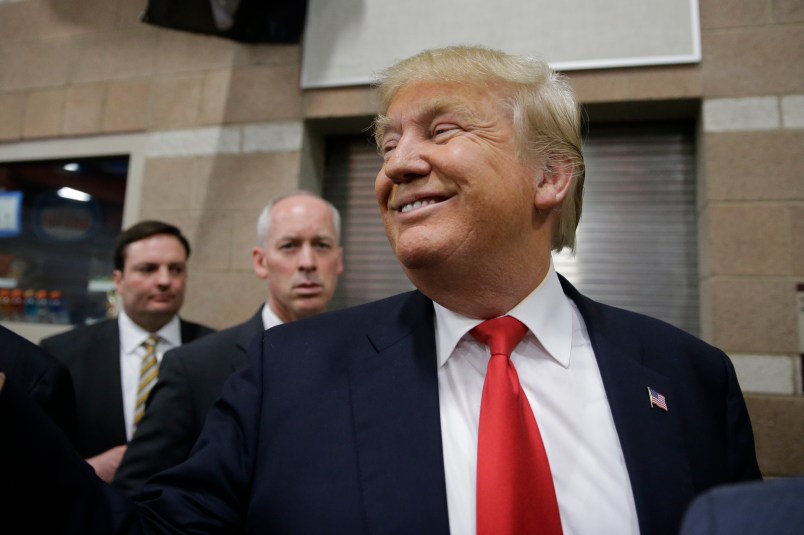After TPM’s pioneering work identifying the new metrical form of the Trump attack haiku, readers came through with a more extensive examination of Trump’s work …
TPM Reader RM …
I am a prime subscriber (userid: xxxxxxx). Another way to look at Trump’s twitter approach is that it’s more like a mini-debate in which he wins all the time.
1. Statement which acknowledges an opponent or an opponent’s statement, and implicitly takes the risk of giving that opponent added publicity.
2. Statement deriding or ridiculing the opponent with reliance on some factual event.
3. Add final declaratory opinion or demand.Sometimes #1/#2 are in the same sentence, but that is a function of Twitter’s character limitations. #3 is almost always a separate statement. Take the Romney tweet on taxes as an example:
– Acknowledge Mitt Romney said something about Trump (many might not have known and might be curious about what he said and the validity of it).
– Statement that Mitt Romney was a terrible candidate and is therefore compromised in discussing all matters Trump.
– Declaratory statement: Dope!Imagine if John Kerry had used this same method (had Twitter been around) in 2004 against the Swift Boat Attacks:
1. Bush and his cronies are attacking my war record through swift boat lies.
2. Bush was a draft dodger who hid behind his momma’s skirt to get out of serving.
3. “Liar!” or “Hypocrite!”Something like that might’ve gone viral, and liberal minded voters might’ve rallied to him and more effectively neutralized the impact of those ads.
I would say this is possible. But I also think the attack haiku is more natural to the right and its instinctive attraction to ‘dominance politics‘. One might even say that the attack haiku is dominance politics’ native literary form. So I’m not sure this would have worked for Kerry.
Next TPM Reader NH …
Sadly (or happily) I am not an English professor, but I did major in English, with a personal focus on formal poetry and prosody, through high school and college. I certainly considered myself my professors’ equal at the time, and so see no reason why I shouldn’t offer my analysis in this case.
Technically speaking, you’ve not identified a metre in Trump’s tweets, merely a poetic form. Metre is the pattern of stressed and unstressed syllables constituting the musical quality of formal poetry. So your observation stands, but does not go far enough.
Yet the question of Trumpic metre is fascinating, so I’ve been doing basic two-level scansion of the tweets you identified for the last half-hour. (Obviously, being an English major, I’m currently underemployed.)
I’ve identified inconsistent but undeniable metrical work by Trump across these formal tweets. (I propose to call this poetic form the Trumpett, a name after the Sonnett, but appropriately drawing on simplistic pun and base visual humor.) The first Tweet you identified is a wonderful example:
(Be sure to view this scansion in fixed-width font, without the lines wrapping.) Here we see a three-line poem consisting of one line of antibacchiuc pentameter, which is very unusual, one line of dactylic heptameter, and a final line of a single stressed syllable, which is not even metrical.
I would argue this final line is definitional to the form, communicating the shattering of formal expression, sociopolitical convention, and basic reason, which destruction identifies for us the Trumpic poetics. In other instances the final line is two or even three syllables, but never enough to provide us with a metrical pattern.
And yet patterns exist clearly in the prior lines. A detailed analysis of them is both beyond the scope of this email and likely not fruitful, since the Trumpett form does not appear to define a specific meter required in its initial lines.
Rather, its mechanism is to gesture towards formality in the initial couplet, and then use the abrupt ametricality of the final line to overwhelm the readers’ anticipation of rhythm, implying the force of the sheer authority of Trump’s judgement.
Finally, TPM Reader LP, with what is definitely my favorite …
English professor here. I would give you an A for both close reading and literary analysis. What I notice is that the first 2 sentences present information that works like Oppo research, presenting a negative of the tweet’s target. Then the closing stanza (if you will) presents his judgment or interpretation. He goes from some specific in the first 2 statements to a general point. “Loser!” “Bad!” That’s the way arguments end in bars late at night and in school yards.
Twitter is perfect for this sort of haiku-like political discourse; he creates a mini-argument with no room for rebuttal. Who can argue these statements, as they conclude with his opinion on the matter? I think this is one source of his appeal—what makes him look like he speaks his mind and refuses to be politically incorrect.
I think you nailed it, with no help from anyone else.
I do not feel we have gotten to the bottom of this. So I’m still interested to hear from experts on rhetoric, poetics and other literary stuff on this question.







